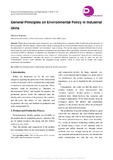| dc.description.abstract | Within the environmental policy framework, one could distinguish two categories, both of which aim at the protection of
the environment. The first category is based on the concept of reducing the use of non-renewable resources and energy, as well as on
the replacement of “poisonous elements” and “hazardous” types of energy. This second category includes different kind of actions
which tackle the issue of unwanted by-products of production and consumption. More specifically, it includes measures that aim at:
conversion of leftover substances or materials (e.g. elimination of poisonous gas), utilization of leftover substances or materials,
waste avoidance, reduction of waste production, waste “dispersion” which includes “decentralization” (disposal) and “centralization”
(collection). “Decentralization” describes the process of controlled diffusion (emission) of waste in water, air and soil.
“Centralization” involves waste collection into designated storage premises, which of course need to comply with certain
requirements and regulations. | en_UK |


